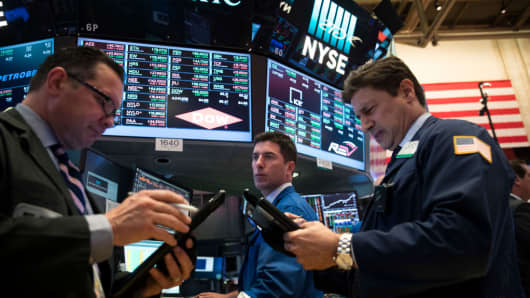U.S. stocks rose to record levels Friday and posted strong weekly gains.
The Dow Jones industrial average rose 64.86 points to close at 22.2686.34, a record. Boeing, 3M and Apple contributed the most to the gains. The index also posted an intraday high of 22,275.02
The S&P 500 also notched record highs, advancing 0.2 percent to finish at 2,500.23. Friday also marked the first time the index broke above 2,500. Information technology and financials were among the best-performing sectors.
The Nasdaq composite outperformed, closing 0.3 percent higher at 6,448.47; it also managed to an intraday record of 6,464.27.
“People are always looking for a reason for the market to go down but stocks keep going up and earnings remain strong,” said JJ Kinahan, chief market strategist at TD Ameritrade.
Tech stocks kicked off the session as the worst performers before turning around in late-morning trading. Shares of Apple and Facebook both closed higher.
The three major indexes finished the week at least 1.4 percent higher. The Dow also notched its biggest weekly gain since the week of Dec. 9.
 “The market has been digesting its gains in a consolidation phase following Monday’s gap up” in the S&P 500, said Katie Stockton, chief technical strategist at BTIG, in a note. “The breakouts that have developed suggest overbought conditions will be absorbed without a significant pullback.”
“The market has been digesting its gains in a consolidation phase following Monday’s gap up” in the S&P 500, said Katie Stockton, chief technical strategist at BTIG, in a note. “The breakouts that have developed suggest overbought conditions will be absorbed without a significant pullback.”
The SPDR S&P Bank exchange-traded fund (KBE) gained 4.2 percent for the week, its biggest weekly rise since June. The jump comes on the back of stronger-than-expected inflation numbers which increased expectations for a Federal Reserve rate hike.
The Labor Department said Thursday that the consumer price index rose 1.9 percent last month on a year-over-year basis. Market expectations for a December Fed rate hike are now at 52.9 percent, according to the CME Group’s Fedwatch tool.
“Although CPI remains below the FOMC’s 2% target, the move back higher should be enough to convince most observers that the Q2 weakening was a temporary phenomenon and that this version of inflation should be able to move back above 2.0% during the 4th quarter,” said Michael Shaoul, chairman and CEO of Marketfield Asset Management, in a note to clients.
“Our own view is that current consensus underplays the degree to which CPI has been held back by the long commodity bear market that extended well beyond energy prices,” Shaoul said.
The Fed is scheduled to announce its latest decision on monetary policy next week. Most market participants do not expect a rate hike. However, the central bank is projected to announce the unwinding of its massive $4.5 trillion portfolio. The Fed accrued most of its holdings during the financial crisis.
U.S. Treasury yields have also surged this week. The benchmark 10-year yield started the week near 2.09 percent; it traded around 2.19 percent Friday.
Wall Street digested two key data sets Friday ahead of the Fed’s meeting.
Retail sales for August fell 0.2 percent. Economists polled by Reuters expected a 0.1 percent gain.
“I think Hurricane Harvey had a bit of an impact on the data,” said Christian Magoon, CEO of Amplify ETFs.
Meanwhile, industrial production fell nearly 1 percent last month.
Investors also looked to Asia after North Korea launched a missile that flew over Japan and landed in the Pacific Ocean. Still, world markets had a mixed reaction to the event. The European Stoxx 600 index fell 0.3 percent while the Japanese Nikkei 225 rose 0.52 percent.
“You could spin this as resiliency or complacency,” said Magoon. “This market seems a bit out of touch with reality. … The risk to the downside is not getting as much respect as the upside risk.”






